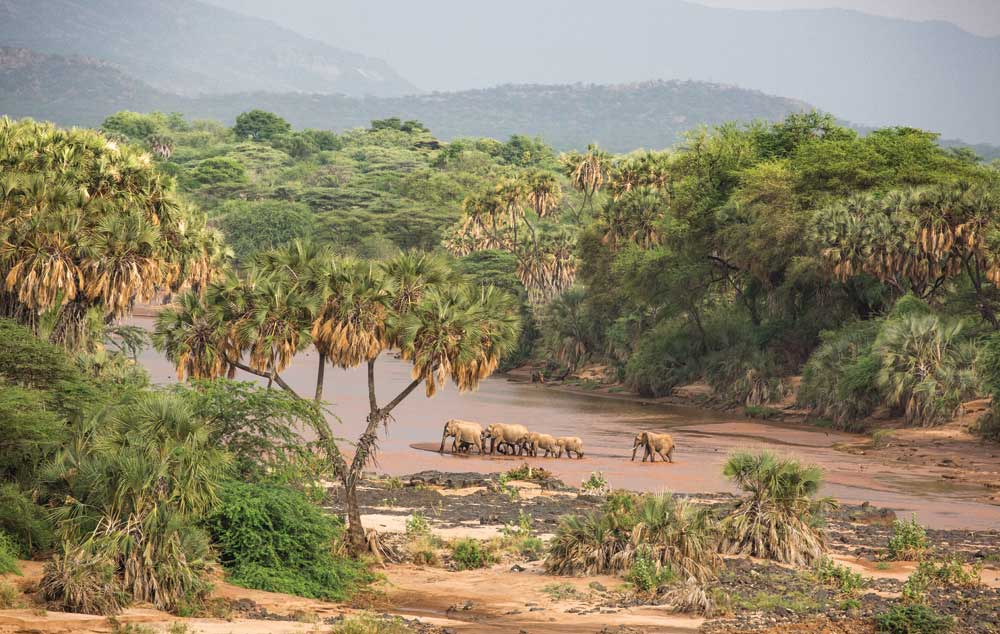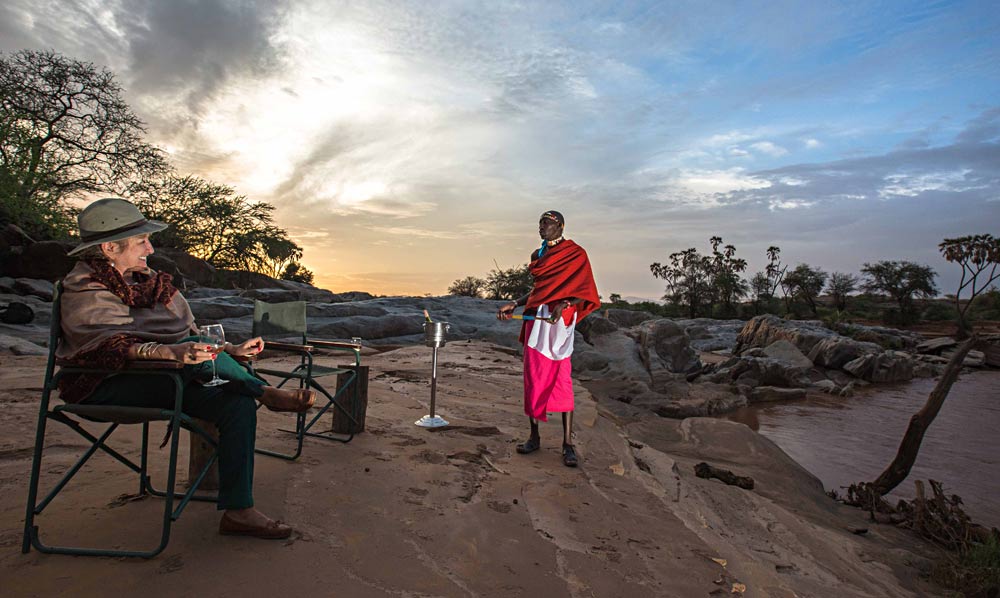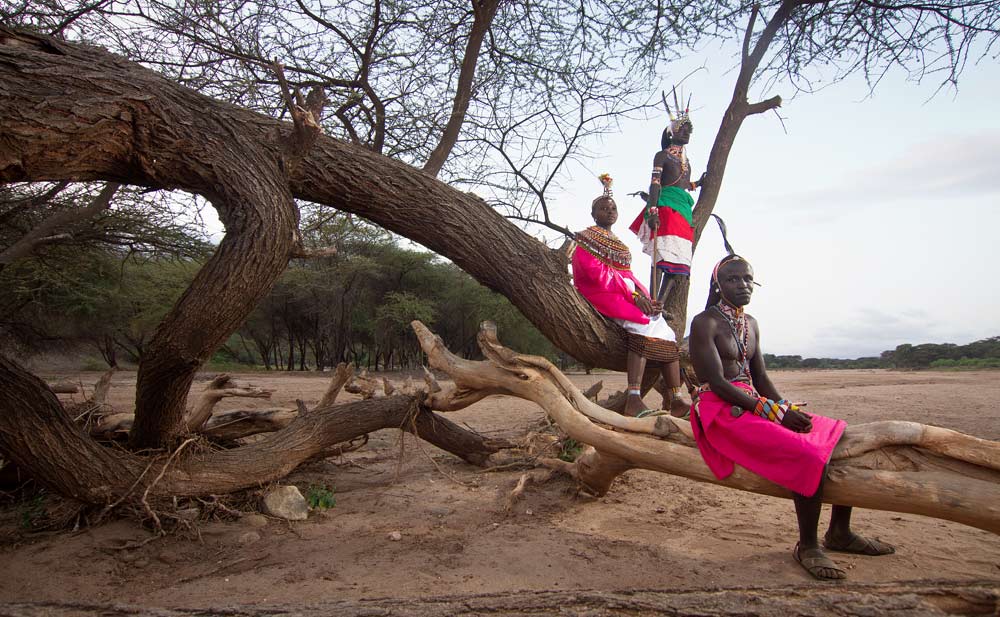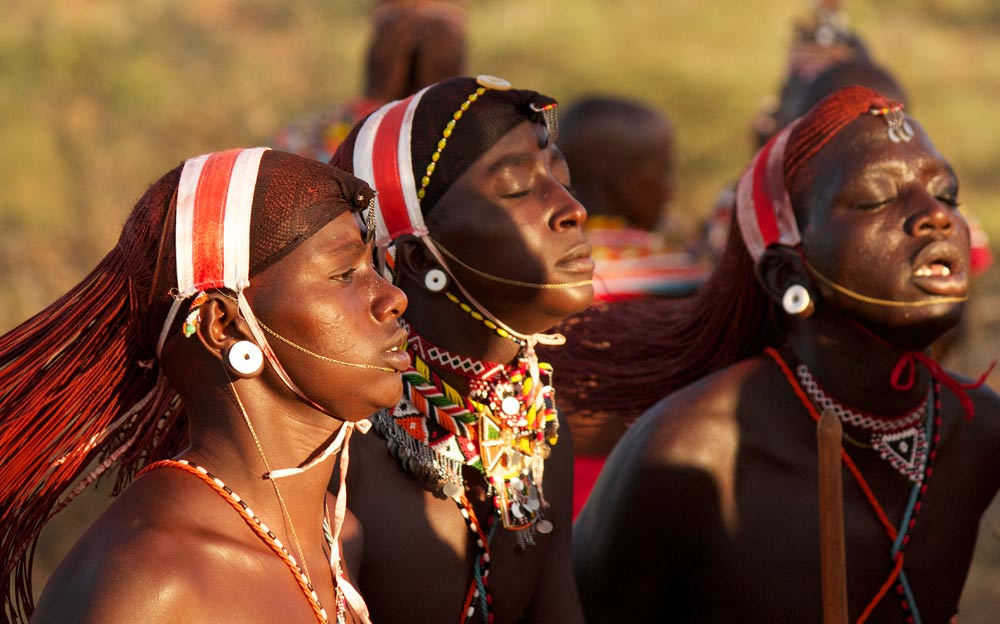There’s no better way to learn about the fascinating culture of the Samburu people than sitting down and chatting with warrior. And even better if it happens to be over a glass of chilled wine while watching the sun set and the elephants wade across the Ewaso Nyiro River in Shaba National Reserve.

Night falls in Shaba National Reserve
The light is fading from grey to lilac and the baboons are streaming down to the riverbank. It’s their bedtime and they’re swarming up the trunks of the doum palms to lay claim to the best forks in the branches. Like all children, the young baboons resist the onset of bedtime. They’re chasing each other around the huge boulders that line the Ewaso Nyiro River. A tiny creature, all pink face and brown fluff, tumbles off the edge of a rock the size of a giant’s billiard ball. Quick as a flash, another hand is extended. The infant dangles briefly and is hauled back to safety. From the doum palms comes a cackle of maternal alarm.

We set up our sundowner camp
On the other side of the river we’ve set up camp for ‘sundowners.’ We’re on a natural beach, on a bend in the river. It’s a sublime spot, backed by surreally sculptured boulders. Better still, it delivers long views down the cocoa-brown river. The sundowner tradition dates back to the time of the great game-hunting safaris of the 1900s. Then, European royalty and American wealth streamed to Kenya to hunt the ‘Big Five’; now the hunting culture is dead and gone. But the Samburu culture, immeasurably more ancient and profound, lives on.
And one of its sons is sitting with us.

Clad in brilliant colours and embellished with bandoliers of beads, Lejale has guided us on our travels through the painted deserts of northern Kenya. Now, as the thick brown river slips silently past and the baboons melt into the shadows, he deems it time to deliver his Cultural Talk. Well, why not?
The Samburu talk fast
And so he begins with the tale of how the brother-tribes of the Maasai, Njemps, Samburu and Laikipia migrated to Kenya from Southern Sudan some time in the 17th century. He tells us how the Laikipia elected to remain on the flanks of Mount Kenya while the other three tribes pushed on for warmer climes. It was a bad decision: their cattle died and they were reduced to pursuing their former clansmen and raiding their cattle. ‘But,’ declaims Lejale, arms extended like some prophet descended from the mountain, ‘they were defeated and now the people once known as the Laikipia are no more. Which leaves only the Njemps, who settled around the shores of Lake Baringo, and the Maasai and the Samburu.’ He glances at us, struck by a thought. ‘Do you know how to tell the difference between a Maasai and a Samburu?’ he asks.

We don’t. The answer is complex involving subtle nuances of hairstyle and headdress and arcane placements of knives in belts. Sensing our confusion, Lejale condenses matters. ‘The Maasai talk slowly,’ he says, ‘the Samburu talk fast’.
And this seems to settle things. For him at least.
The rites of passage of the Samburu
We move on to study the rituals of circumcision and coming of age. They’re fascinating but convoluted and eventually boil down to the fact that everything rests on the twin tenets of respect and bravery. An entire family will, for instance, be irretrievably disgraced if a would-be warrior shows fear in the face of the circumcision knife. But happy are those who come through this ordeal unscathed. Admitted to the sacred ranks of warrior-hood, they will enjoy white robes of triumph, magnificent feathered headdresses and lilting lines of undulating maidens.

As the wine sinks in the bottle, we turn briefly to the mathematics of barter. We learn that, roughly speaking, one camel = 24 goats, one heifer = twelve goats, one male calf = three goats. Which firmly establishes goats as the common currency of Samburu-land. But now the light is dimming and far behind us rises the great bulk of Ololokwe, the Sacred Mountain of the Samburu. A massive flat-topped mesa that glowers over the landscape, this is the home of the Samburu God, Enkai.
Enkai: the god of the Samburu
‘If Enkai is not shown respect,’ announces Lejale ‘then the Samburu believe that drought will follow. And then our livestock will die and we will perish.’ He leans on his spear. ‘In times of drought, the married women must intercede. Because Enkai listens only to them.’ We gaze at him enquiringly.
‘The married women,’ Lejale says, ‘take up their sacred sticks and set off, singing and dancing as they go, to the foot of the mountain. There, they pour milk and water into the earth and Enkai listens.’
There’s a rumble of thunder downstream. The northern lands have been deluged with rain over the last few days. It’s rare. Typically this land is parched all year round. The songs of the married women must have been particularly lovely this year.
Across the river, we can just make out the hunched shapes of the baboons high in the forks of the palms. The world is midnight blue. It’s time to go home. But, like all good lecturers, Lejale invites final questions. ‘How have the Samburu adapted to modern life?’ we ask. ‘They have not,’ he says simply, ‘why should they?’ ‘Don’t they want the things that modern life can give?’ we suggest. Lejale looks pityingly at us. ‘What they want,’ he says, ‘is goats, camels, cows and sheep.’ ‘What about televisions?’ ‘What use are televisions?’ says Lejale with scorn; ‘there’s no electricity in the village.’
Samburu culture past and present
‘But, don’t your people want to know what’s going on in the world?’ we pursue. The question sounds lame even to us. ‘Don’t they want to know about…’ we hunt for a topic of global relevance, ‘what President Trump is saying, for instance?’ Lejale smiles. ‘Most Samburu don’t know President Trump exists,’ he says benignly. ‘So what does matter to you?’ we persevere. Silhouetted against the silent brown river, Lejale considers.

‘Mobile phones and motorbikes,’ he concedes, ‘education and culture’. At the mention of culture, his chin goes up. ‘It is thanks to our culture, that there is virtually no crime in Samburu land,’ he says, ‘and that the old and sick are always cared for. And it is out of respect for our culture that we share all that we have for the communal good.’ The inference is obvious. President Trump hasn’t a hope. As we pack up the chairs and grope our way back to the vehicle there’s one more question to be asked.
‘And what about you, Lejale? What’s your goal in life?’
‘I,’ says Lejale, ‘would like to be a politician.’
Shaba National Reserve: Need to know
Shaba National Reserve lies in northern Kenya, close to Samburu and Buffalo Springs National Reserves. Well off the beaten tourist track, it makes a magnificent backdrop to a very special sundowner experience.
This story took place on the banks of the Ewaso Nyiro River. Sundowners were organized by Sarova Shaba Game Lodge, who also provided our accommodation and our guides. Lejale is the lodge’s cultural attaché. He is also an inspired game tracker.
The Sarova Shaba Game Lodge stands central to the three northern national reserves of Shaba, Samburu and Buffalo Springs. For further information: www.sarovahotels.com.
We travelled to Kenya’s arid north flying with Safarilink who offer daily flights to the region. For further details contact: www.flysafarilink.com
© 2025 Kenya Holidays
